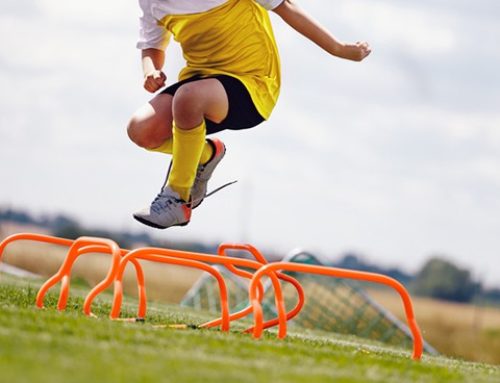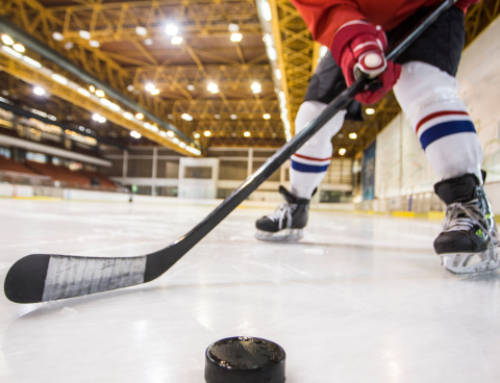How to Avoid Hockey Conditioning That Slows You Down
Tell me what you do for your hockey conditioning or cardio training, and I will tell you how close you are to reaching your potential for speed and stamina.
There are two extremes on the hockey-conditioning continuum. At one end are the players who still think a 3- to 5-mile run two or three times per week is all they need to build their stamina. They might be the same guys who still use wooden sticks.
Then there are the players who are up on the latest fad, and all they do is high intensity interval training (HIIT). They got the idea from an infomercial they saw and tried the program: “Man, it’s like impossible. I was dripping sweat in like 5 minutes—sooooo hard, whew, I did like 90 seconds straight of Squat Jumps and then these crazy Push-ups. It was intense!”
Hear that sound? It sounds like a vacuum cleaner. That is the sound of speed being sucked right out of your legs.
Different training approaches, but the same outcome. You may burn more calories doing the second type of interval workout, but you won’t improve your speed and your ability to play at both ends of the ice.
Here are the problems with each type of hockey conditioning:
Steady-State Training
This is your 5-mile run. Even if you are going hard the whole time, you cannot sprint full out for even 400 meters, let alone 5 miles. So although you may be pushing yourself, you are not going fast, and you are not teaching your body to go fast.
I have seen many of you do your 3- to 5-mile runs, and you are actually not even pushing yourself that hard. You are plodding along, putting in your time. You are working at a low intensity. You can see that this will not put that jump into your legs that you need on the ice.
These steady-state sessions should be used sparingly and only considered as recovery.
Hard Core HIIT
This is a perfect example of a good idea gone bad. High Intensity Interval Training done properly will improve your speed and your stamina—exactly what you need on the ice—but it has to be done with the right mix of work and rest.
As I pointed out above, it is impossible to sprint full out for 400 meters (which takes around 60 seconds for a good hockey player.) Despite your effort, you will still hit a wall. Around 30 seconds into the interval, it will feel like the muscle has been sucked from your legs and replaced by lead. Despite your intentions, you are getting slower and slower and slower—and you still have another 60 seconds to go!
So during that 90-second interval, you might be teaching your body to be fast for the first 20-30 seconds, but then you’re teaching it to be slow for the last 60-70 seconds. Not really the message you want to send, is it?
Now, compound that fatigue by adding another 90-second interval when you are still in the zone of fatigue, and you can see how it is a downward spiral into survival mode.
When used on occasion, these workouts definitely can have mental toughness benefits, but you pay the price in lost speed on the ice when you use this type of training as your typical cardio session.
RELATED: The Tabata Protocol for Hockey Conditioning
A Better Way to Train
Here’s how your hockey conditioning can improve your speed on the ice.
- Keep your intervals to 30 seconds or less.
- Allow for 60-90 seconds of recovery between intervals. This can be skill, mobility or core training—not hangin’ out by the water fountain.
- Go for a total of 10 intervals (yes, I know that is only 5 minutes of work.) This will teach your body to go hard and then recover again and again.
- Make every second interval session multi-directional. Adding stops and starts will challenge your muscles in a more hockey-specific way.
- If you are fatiguing to the point where you lose form or get slow, either decrease the work interval or increase the rest slightly.
Don’t get me wrong. You need to work hard and learn to work when you are fatigued. But if you constantly batter your body and operate in the zone of fatigue during the majority of your hockey conditioning sessions, you will wear yourself down and drain speed from your legs.
Anyone can make himself tired. Your goal should be to play better hockey, to log big minutes and cement your spot on the top unit.
For extra motivation, check out Red Wings Henrik Zetterberg’s training routine in the video player above.
RECOMMENDED FOR YOU
MOST POPULAR
How to Avoid Hockey Conditioning That Slows You Down
Tell me what you do for your hockey conditioning or cardio training, and I will tell you how close you are to reaching your potential for speed and stamina.
There are two extremes on the hockey-conditioning continuum. At one end are the players who still think a 3- to 5-mile run two or three times per week is all they need to build their stamina. They might be the same guys who still use wooden sticks.
Then there are the players who are up on the latest fad, and all they do is high intensity interval training (HIIT). They got the idea from an infomercial they saw and tried the program: “Man, it’s like impossible. I was dripping sweat in like 5 minutes—sooooo hard, whew, I did like 90 seconds straight of Squat Jumps and then these crazy Push-ups. It was intense!”
Hear that sound? It sounds like a vacuum cleaner. That is the sound of speed being sucked right out of your legs.
Different training approaches, but the same outcome. You may burn more calories doing the second type of interval workout, but you won’t improve your speed and your ability to play at both ends of the ice.
Here are the problems with each type of hockey conditioning:
Steady-State Training
This is your 5-mile run. Even if you are going hard the whole time, you cannot sprint full out for even 400 meters, let alone 5 miles. So although you may be pushing yourself, you are not going fast, and you are not teaching your body to go fast.
I have seen many of you do your 3- to 5-mile runs, and you are actually not even pushing yourself that hard. You are plodding along, putting in your time. You are working at a low intensity. You can see that this will not put that jump into your legs that you need on the ice.
These steady-state sessions should be used sparingly and only considered as recovery.
Hard Core HIIT
This is a perfect example of a good idea gone bad. High Intensity Interval Training done properly will improve your speed and your stamina—exactly what you need on the ice—but it has to be done with the right mix of work and rest.
As I pointed out above, it is impossible to sprint full out for 400 meters (which takes around 60 seconds for a good hockey player.) Despite your effort, you will still hit a wall. Around 30 seconds into the interval, it will feel like the muscle has been sucked from your legs and replaced by lead. Despite your intentions, you are getting slower and slower and slower—and you still have another 60 seconds to go!
So during that 90-second interval, you might be teaching your body to be fast for the first 20-30 seconds, but then you’re teaching it to be slow for the last 60-70 seconds. Not really the message you want to send, is it?
Now, compound that fatigue by adding another 90-second interval when you are still in the zone of fatigue, and you can see how it is a downward spiral into survival mode.
When used on occasion, these workouts definitely can have mental toughness benefits, but you pay the price in lost speed on the ice when you use this type of training as your typical cardio session.
RELATED: The Tabata Protocol for Hockey Conditioning
A Better Way to Train
Here’s how your hockey conditioning can improve your speed on the ice.
- Keep your intervals to 30 seconds or less.
- Allow for 60-90 seconds of recovery between intervals. This can be skill, mobility or core training—not hangin’ out by the water fountain.
- Go for a total of 10 intervals (yes, I know that is only 5 minutes of work.) This will teach your body to go hard and then recover again and again.
- Make every second interval session multi-directional. Adding stops and starts will challenge your muscles in a more hockey-specific way.
- If you are fatiguing to the point where you lose form or get slow, either decrease the work interval or increase the rest slightly.
Don’t get me wrong. You need to work hard and learn to work when you are fatigued. But if you constantly batter your body and operate in the zone of fatigue during the majority of your hockey conditioning sessions, you will wear yourself down and drain speed from your legs.
Anyone can make himself tired. Your goal should be to play better hockey, to log big minutes and cement your spot on the top unit.
For extra motivation, check out Red Wings Henrik Zetterberg’s training routine in the video player above.
[cf]skyword_tracking_tag[/cf]











